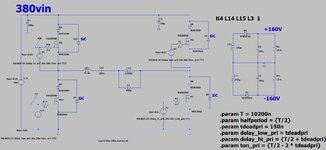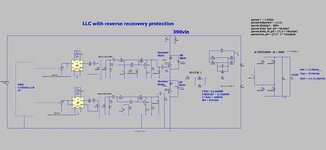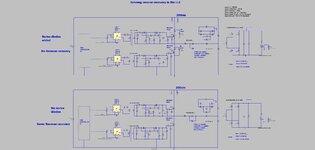cupoftea
Advanced Member level 6

Pages 13, 14 and 15 of the following show that in typical LLC converters using typical offtheshelf LLC controller IC’s, capacitive mode destruction (due to severely ruinous reverse recovery current) simply cannot be avoided….
https://www.infineon.com/dgdl/Infin...N.pdf?fileId=5546d4625b3ca4ec015b3e58e44f1048
The way to avoid it, as they say, is to put in a current transformer, and measure the phase shift between the resonant capacitor current, and the MOSFET gate signals. As soon as the phase gets to zero, then the “next” MOSFET should not be switched ON, and the currently ON MOSFET should be switched OFF.
Another way to solve the problem of severe reverse recovery though, is simply to add low Vf diodes in series with the FETs, and SiC diodes in pllel to both fet and low Vf diode, as in the attached, would you agree?
(LTspice and JPG schem attached)
Another way woudl be to use SiC FETs....i wonder why the app note didnt suggest this?
https://www.infineon.com/dgdl/Infin...N.pdf?fileId=5546d4625b3ca4ec015b3e58e44f1048
The way to avoid it, as they say, is to put in a current transformer, and measure the phase shift between the resonant capacitor current, and the MOSFET gate signals. As soon as the phase gets to zero, then the “next” MOSFET should not be switched ON, and the currently ON MOSFET should be switched OFF.
Another way to solve the problem of severe reverse recovery though, is simply to add low Vf diodes in series with the FETs, and SiC diodes in pllel to both fet and low Vf diode, as in the attached, would you agree?
(LTspice and JPG schem attached)
Another way woudl be to use SiC FETs....i wonder why the app note didnt suggest this?
Attachments
Last edited:



